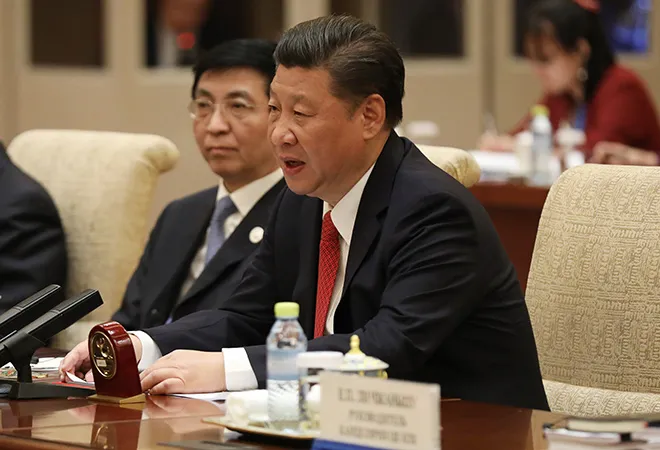 This is the 79th article in the series
This is the 79th article in the series The China Chronicles.
Read all the articles here.
Even as Indian elections are underway, observers would do well to keep track of an equally consequential event taking place in late April: the second Belt and Road Forum. Two years ago, Beijing hosted 30 world leaders to trumpet and legitimize its infrastructure connectivity initiative. While the Belt and Road Initiative (BRI) was conceptualized in 2013, the first Belt and Road Forum symbolized how much of a force it had truly become in international politics.
Since then, the world has adapted and responded to China’s propositions. Ahead of the second Forum, then, it is useful to take stock of how major powers have responded to the BRI. The most consequential change is likely America’s response. From sending official representation to the first BRI forum to labelling China a “revisionist power” a year later, the US’ posture has shifted considerably from one of possible cooperation to outright competition. In fact, the much-vaunted Indo-Pacific construct and strategy was born out of this very change. It seeks to provide a “rules-based” connectivity and security alternative in the region. Washington is systematically reallocating state resources, private investment and human capital to compete with what it considers a near peer rival.
The second is the European Union’s “collective” response. Barely a year ago, China was pressing to partner with the EU to temper American economic nationalism. The tides have turned quickly however. Just last month, the EU labelled China a “systemic rival” that is promoting alternative models of governance. China’s growing influence across Eurasia have compelled the EU to reinvest in geopolitical initiatives—epitomized by the release of a new EU-Asia connectivity strategy, which is a direct response to the BRI.
China’s growing influence across Eurasia have compelled the EU to reinvest in geopolitical initiatives—epitomized by the release of a new EU-Asia connectivity strategy, which is a direct response to the BRI.
Third, Japan and Australia have reassessed the BRI. Japan, which was an early critic, is now attempting to find synergy with the initiative in order to limit competition with China and find opportunity for its own businesses. Meanwhile, Australia was on the fence at first, but has since tracked Beijing’s influence operations and investments in Australian sub-national governments and the Pacific with worry. Canberra has even set up a USD 1.5 billion fund to compete with the BRI in the Indo-Pacific. Both states will likely continue this balancing act given their own unique economic and geopolitical relationship with Beijing.
The final consequential change is China’s own policy planning. Since 2013, billions of dollars have flown from Chinese entities to the developing world. The profligacy of spending and China’s poor transparency record led to some predictable outcomes: many host nations were saddled with massive government debt. China is now responding to this criticism and has promised to allay concerns about “debt traps” at the second BRI Forum. Beijing has also constituted a new international development agency in an attempt to make more rational assessments of risk and opportunity along the BRI.
While these are certainly consequential changes, it is also evident that the BRI is here to stay. So, what hasn’t changed? For one thing, despite the ostensible risks of “debt traps”, most developing states (correctly) continue to see value in China’s infrastructure investments. In fact, these states have used the pushback against the BRI to gain economic concessions from Beijing. Malaysia’s Prime Minister Mahathir, for example, is renegotiating terms of a BRI project with China only months after he came to power on a vehemently anti-China campaign. Given trillions of dollars in infrastructure demand in Asia and Africa, this dynamic will likely repeat across much of the developing world.
Second, despite the EU’s desire to act collectively, member state responses remain discordant. Just last month, Italy became the first G-7 country to sign onto the BRI. This April, Greece formally entered the 16+1 (now 17+1) arrangement which pairs China with Central and Eastern European nations; who have themselves often sided with China on issues such as the South China Sea and human rights in Xinjiang. Even powers such as Germany are struggling to manage their commercial interdependence with Beijing. Despite the US’ diplomatic offensive against Huawei, for example, Berlin appears set to allow the firm to bid on its 5G infrastructure.
Third, Russia remains cautiously invested in the bilateral with China. While Moscow was initially wary of the BRI in 2013, geopolitical tensions with the West have compelled it to rely more heavily on China. This is a relationship with uncertain long-term sustainability—the economic asymmetry between China and Russia is bound to become a source of friction. Nonetheless, short term trends indicate that the relationship is strong; both states are converging in Central Asia, and increasingly the Arctic Ocean as well. President Putin, meanwhile, is slated to attend in the second Forum.
While Moscow was initially wary of the BRI in 2013, geopolitical tensions with the West have compelled it to rely more heavily on China. This is a relationship with uncertain long-term sustainability.
Finally, India remains deeply mistrustful of China’s ambitions and intentions. India was the first major power to vocalize discontent with the BRI, refusing to send a delegate to the first Forum in May 2017. It looks increasingly likely that India will once again be conspicuous in its absence. On the other hand, India recently set up a new Indo-Pacific division within the MEA—and has strengthened its “matrix of cooperation” in the region more generally. India is a rising Asian power with its own vision and arrangements for the world. It is unlikely that it will ever acquiesce to unilateral initiatives like the BRI that undermine its ability to expand its interests.
Setting aside individual state responses, a more macro-outlook reveals that postures towards the BRI are dramatically reconfiguring extant political, economic and security relationships. The BRI is fast evolving from a patchwork of infrastructure investments to an alternative model for the international system centered around Beijing. The second BRI Forum will certainly testify to this reality. But it will also take place amidst an increasingly coordinated pushback from established and emerging powers. Indeed, the second Belt and Road Forum will give us a better sense of how the BRI, and the various responses to it, will shape the 21st century world order.
The views expressed above belong to the author(s). ORF research and analyses now available on Telegram! Click here to access our curated content — blogs, longforms and interviews.



 This is the 79th article in the series The China Chronicles.
Read all the articles
This is the 79th article in the series The China Chronicles.
Read all the articles  PREV
PREV


